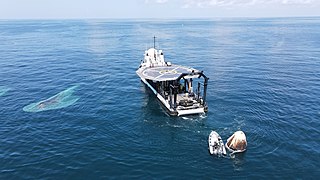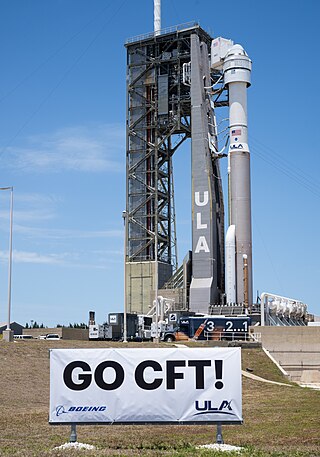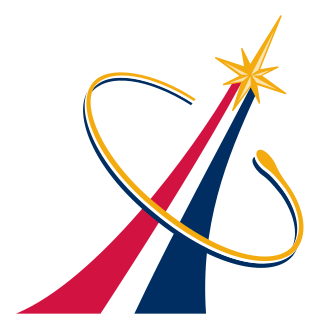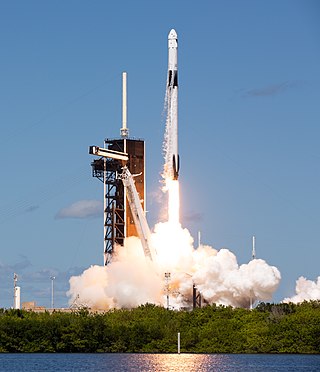
Harmony, also known as Node 2, is the "utility hub" of the International Space Station. It connects the laboratory modules of the United States, Europe and Japan, as well as providing electrical power and electronic data. Sleeping cabins for four of the crew are housed here.

The Boeing Starliner is a class of partially reusable spacecraft designed to transport crew to the International Space Station (ISS) and other low-Earth-orbit destinations. It is manufactured by Boeing, with the Commercial Crew Program (CCP) of NASA as the anchor customer. The spacecraft consists of a reusable crew capsule and an expendable service module.

The US Orbital Segment (USOS) is the name given to the components of the International Space Station (ISS) constructed and operated by the United States National Aeronautics and Space Administration (NASA), European Space Agency (ESA), Canadian Space Agency (CSA) and Japan Aerospace Exploration Agency (JAXA). The segment consists of eleven pressurized components and various external elements, almost all of which were delivered by the Space Shuttle.

Development of the Commercial Crew Program began in the second round of the Commercial Crew Development (CCDev) program, which was rescoped from a technology development program for human spaceflight to a competitive development program that would produce the spacecraft to be used in the Commercial Crew Program to provide crew transportation services to and from the International Space Station (ISS). To implement the program NASA awarded a series of competitive fixed-price contracts to private vendors starting in 2011. Operational contracts to fly astronauts were awarded in September 2014 to SpaceX and Boeing, and NASA expected each company to complete development and achieve crew rating in 2017. Each company performed an uncrewed orbital test flight in 2019. SpaceX operational flights started in November 2020.

Dragon 2 is a class of partially reusable spacecraft developed, manufactured, and operated by American space company SpaceX, primarily for flights to the International Space Station (ISS). SpaceX also launches private missions, such as Inspiration4 and Axiom Space Missions. There are two variants of the Dragon spacecraft: Crew Dragon, a spacecraft capable of ferrying four crewmembers, and Cargo Dragon, a replacement for the original Dragon 1 used to carry freight to and from space. The spacecraft consists of a reusable space capsule and an expendable trunk module. The spacecraft launches atop a Falcon 9 Block 5 rocket and the capsule returns to Earth through splashdown. It has proven to be the most cost effective spacecraft in history to be used by NASA.

Crew Dragon Demo-1 was the first orbital test of the Dragon 2 spacecraft. The mission launched on 2 March 2019 at 07:49:03 UTC, and arrived at the International Space Station on 3 March 2019, a little over 24 hours after the launch. The mission ended following a successful splashdown on 8 March 2019 at 13:45:08 UTC.

Crew Dragon Demo-2 was the first crewed test flight of the Crew Dragon spacecraft. The spacecraft, named Endeavour, launched on 30 May 2020 on a Falcon 9 rocket, and carried NASA astronauts Douglas Hurley and Robert Behnken to the International Space Station in the first crewed orbital spaceflight launched from the United States since the final Space Shuttle mission in 2011, and the first ever operated by a commercial provider. Demo-2 was also the first two-person orbital spaceflight launched from the United States since STS-4 in 1982. Demo-2 completed the validation of crewed spaceflight operations using SpaceX hardware and received human-rating certification for the spacecraft, including astronaut testing of Crew Dragon capabilities on orbit.

The Boeing Starliner Orbital Flight Test was the first orbital mission of the CST-100 Starliner spacecraft, conducted by Boeing as part of NASA's Commercial Crew Program. The mission was planned to be an eight-day test flight of the spacecraft, involving a rendezvous and docking with the International Space Station (ISS), and a landing in the western United States. The mission was launched on 20 December 2019 at 11:36:43 UTC or 06:36:43 AM EST; however an issue with the spacecraft's Mission Elapsed Time (MET) clock occurred 31 minutes into flight. This anomaly caused the spacecraft to burn into an incorrect orbit, preventing a rendezvous with the International Space Station (ISS). The mission was reduced to just two days, with the spacecraft successfully landing at White Sands Space Harbor on 22 December 2019.

Boeing Crew Flight Test (Boe-CFT) will be the first crewed mission of the Boeing Starliner and the third orbital flight test of the Starliner overall after the two uncrewed orbital flight tests, Boe-OFT and Boe-OFT 2 in 2019 and 2022. The flight was scheduled for liftoff at 2:34 on 7 May UTC, but was scrubbed about two hours before liftoff. The cause of the 6 May 2024 mission scrub was due to an oxygen valve problem on the United Launch Alliance's (ULA) Atlas V, and not due to any anomaly on the Starliner portion of the rocket. The launch is now scheduled to occur no earlier than 17 May at 22:16 UTC.

Boeing Starliner-1 also called Post Certification Mission-1 (PCM-1) is planned to be the first operational crew mission of the Boeing Starliner to the International Space Station (ISS) as part of the Commercial Crew Program. It would be the fourth orbital flight mission of the Starliner overall. It is scheduled to launch no earlier than early 2025, transporting members of a future ISS Expedition.

SpaceX Crew-1 was the first operational crewed flight of a Crew Dragon spacecraft, and the maiden flight of the Crew Dragon Resilience spacecraft. It was also the second crewed orbital flight launch by the United States since that of STS-135 in July 2011. Resilience launched on 16 November 2020 at 00:27:17 UTC on a Falcon 9 from Kennedy Space Center Launch Complex 39A (LC-39A), carrying NASA astronauts Michael Hopkins, Victor Glover and Shannon Walker along with JAXA astronaut Soichi Noguchi, all members of the Expedition 64 crew. The mission was the second overall crewed orbital flight of the Crew Dragon.

The Boeing Orbital Flight Test-2 was a repeat of Boeing's unsuccessful first Orbital Flight Test (Boe-OFT) of its Starliner spacecraft. The uncrewed mission was part of NASA's Commercial Crew Program. OFT-2, using Starliner Spacecraft 2, launched 19 May 2022 and lasted 6 days. Starliner successfully docked with the International Space Station (ISS) on 21 May 2022. It stayed at the ISS for 4 days before undocking and landing in the White Sands Missile Range on 25 May 2022.

Boeing Starliner Calypso is a space capsule manufactured by Boeing and used in NASA's Commercial Crew Program. On 20 December 2019, Calypso launched on the Boeing Orbital Flight Test mission, an uncrewed test flight of Starliner to the International Space Station. The spacecraft was scheduled to dock to the ISS and then return to Earth following a week in space, although due to several software issues the spacecraft was unable to rendezvous with the station and landed after two days in space, resulting in Boeing needing to schedule a second Orbital Flight Test.

The Commercial Crew Program (CCP) provides commercially operated crew transportation service to and from the International Space Station (ISS) under contract to NASA, conducting crew rotations between the expeditions of the International Space Station program. American space manufacturer SpaceX began providing service in 2020, using the Crew Dragon spacecraft, and NASA plans to add Boeing when its Boeing Starliner spacecraft becomes operational no earlier than 2025. NASA has contracted for six operational missions from Boeing and fourteen from SpaceX, ensuring sufficient support for ISS through 2030.

Crew Dragon Resilience is a Crew Dragon spacecraft manufactured by SpaceX and built under NASA's Commercial Crew Program. In November 2020, it was launched into orbit to the International Space Station as part of the Crew-1 mission. With crew prompting, Resilience docked autonomously to the station at 04:01 UTC on 17 November 2020, or Day 2 of the mission, marking the first operational docking of a Crew Dragon and the first operational docking of the Commercial Crew Program. The mission carried four additional members of Expedition 64 to the three already on station.

Crew Dragon Endeavour is a Crew Dragon space capsule manufactured and operated by SpaceX and used by NASA's Commercial Crew Program. As of 2024 it has successfully completed four crewed missions to the International Space Station (ISS), and is currently conducting a fifth. It was first launched into orbit atop a Falcon 9 rocket on 30 May 2020 and successfully docked to the International Space Station (ISS) as part of the Crew Dragon Demo-2 mission. This was the first crewed flight test of a Dragon capsule, carrying Doug Hurley and Bob Behnken on first crewed orbital spaceflight from the United States since STS-135 in July 2011 and the first crewed orbital spaceflight by a private company. On 2 August 2020 it returned to Earth. The spacecraft was named by Hurley and Behnken after the Space ShuttleEndeavour, aboard which they first flew into space during the STS-127 and STS-123 missions, respectively. The name Endeavour is also shared by the command module of Apollo 15. The spacecraft's second mission, Crew-2, ended 8 November 2021 after having spent almost 200 days in orbit. Crew Dragon Endeavour set the record for the longest spaceflight by a U.S. crew vehicle previously set by her sibling Crew Dragon Resilience on 2 May 2021. Collectively, Endeavour has spent over 450 days in orbit, the most time in orbit by a crewed spacecraft, surpassing Space Shuttle Discovery.

SpaceX Crew-2 was the second operational flight of a Crew Dragon spacecraft, and the third overall crewed orbital flight of the Commercial Crew Program. The mission was launched on 23 April 2021 at 09:49:02 UTC, and docked to the International Space Station on 24 April at 09:08 UTC.

SpaceX Crew-4 was the Crew Dragon's fourth NASA Commercial Crew operational flight, and its seventh overall crewed orbital flight. The mission launched on 27 April 2022 at 07:52 UTC before docking with the International Space Station (ISS) at 23:37 UTC. It followed shortly after the private Axiom 1 mission to the ISS earlier in the month utilizing SpaceX hardware. Three American (NASA) astronauts and one European (ESA) astronaut were on board the mission.

SpaceX Crew-5 was the fifth operational NASA Commercial Crew Program flight of a Crew Dragon spacecraft, and the eighth overall crewed orbital flight. The mission was successfully launched on 5 October 2022 with the aim of transporting four crew members to the International Space Station (ISS). The Crew Dragon spacecraft docked at the ISS on 6 October 2022 at 21:01 UTC.




























